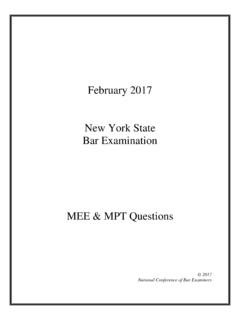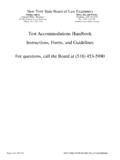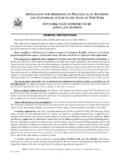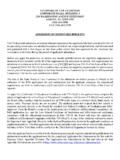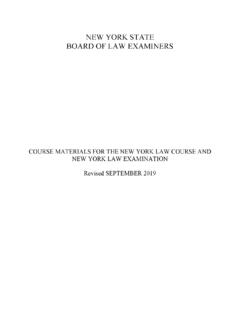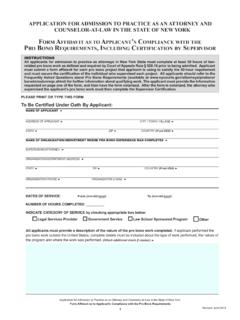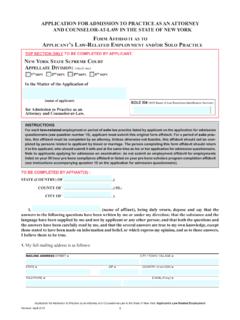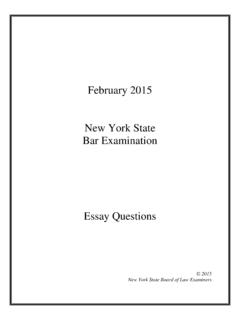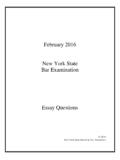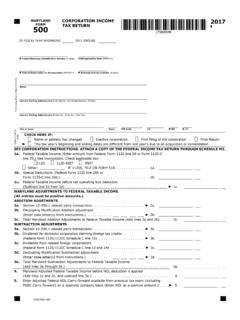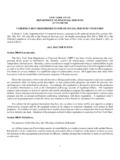Transcription of July 2017 New York State Bar Examination MEE & MPT …
1 July 2017 New york State Bar Examination MEE & MPT Questions 2017 National Conference of Bar Examiners 2017 National Conference of Bar Examiners These materials are copyrighted by the NCBE and are reprinted with the permission of NCBE. These materials are for personal use only and may not be reproduced or distributed in any way. 1 MEE 1 On the evening of July 4, a woman went to the end of her dock to watch a fireworks display on the lake where her house was located. The woman s husband remained inside the house. The fireworks display was sponsored by the lake homeowners association, which had contracted with a fireworks company to plan and manage all aspects of the fireworks display. The fireworks display was set off from a barge in the middle of the lake. During the finale, a mortar flew out horizontally instead of ascending into the sky.
2 The mortar struck the woman s dock. She was hit by flaming debris and severely injured. When the woman s husband saw what had happened from inside the house, he rushed to help her. In his hurry, he tripped on a rug and fell down a flight of stairs, sustaining a serious fracture. All the fireworks company employees are State -certified fireworks technicians, and the company followed all governmental fireworks regulations. It is not known why the mortar misfired. The woman and her husband sued the homeowners association and the fireworks company to recover damages for their injuries under theories of strict liability and negligence. At trial, they established all of the above facts. They also established the following: 1) Nationally, accidents involving fireworks cause about 9,000 injuries and 5 deaths each year. About 15% of these accidents are caused by mortars misfiring in the course of professional fireworks displays, and some of these accidents occur despite compliance with governmental fireworks regulations.
3 2) Even with careful use by experts, fireworks mortars can still misfire. 3) Although a State statute requires a safety zone of 500 feet from the launching site of fireworks when those fireworks are launched on land, the statute does not refer to fireworks launched on water. Neither the homeowners association nor the fireworks company established such a zone. 4) The average fireworks-to-shore distance for this display was 1,000 feet. The woman s dock is 450 feet from the location of the fireworks barge; at only three 2017 National Conference of Bar Examiners These materials are copyrighted by the NCBE and are reprinted with the permission of NCBE. These materials are for personal use only and may not be reproduced or distributed in any way. 2 other points on the lake is there land or a dock within 500 feet of the fireworks barge location.
4 After the conclusion of the plaintiffs case, both the homeowners association and the fireworks company moved for a directed verdict on the basis that the facts established by the evidence did not support a verdict for the plaintiffs. The trial judge granted the motion, based on these findings: 1. Fireworks displays are not an abnormally dangerous activity and thus are not subject to strict liability. 2. Based on the evidence submitted, a reasonable jury could not conclude that the conduct of the fireworks company was negligent. 3. The misfiring mortar was not the proximate cause of the husband s injuries. 4. The homeowners association cannot be held liable for the fireworks company s acts or omissions. As to each of the judge s four findings, was the judge correct? Explain. MEE 2 Businesses in the United states make billions of dollars in payments each day by electronic funds transfers (also known as wire transfers ).
5 Banks allow their business customers to initiate payment orders for wire transfers by electronic means. To ensure that these electronic payment orders actually originate from their customers, and not from thieves, banks use a variety of security devices including passwords and data encryption. Despite these efforts, thieves sometimes circumvent banks security methods and cause banks to make unauthorized transfers from business customers bank accounts to the thieves accounts. 2017 National Conference of Bar Examiners These materials are copyrighted by the NCBE and are reprinted with the permission of NCBE. These materials are for personal use only and may not be reproduced or distributed in any way. 3 To combat this type of fraud, State A recently passed a law requiring all banks that offer funds transfer services to State A businesses to use biometric identification ( , fingerprints or retinal scans) to verify payment orders above $10,000.
6 Although experts dispute whether biometric identification is significantly better than other security techniques, the State A legislature decided to require it after heavy lobbying from a State A based manufacturer of biometric identification equipment. A large bank, incorporated and headquartered in State B, provides banking services to businesses in every State , including State A. Implementation of biometric identification for this bank s business customers in State A would require the bank to reprogram its entire electronic banking system at a cost of $50 million. The bank s own security experts do not believe that biometric identification is a particularly reliable security system. Thus, instead of complying with State A s new law, the bank informed its business customers in State A that it would no longer allow them to make electronically initiated funds transfers.
7 Many of the bank s business customers responded by shifting their business to other banks. The bank estimates that, as a result, it has lost profits in State A of $2 million. There is no federal statute that governs the terms on which a bank may offer funds transfer services to its business customers or the security measures that banks must implement in connection with such services. The matter is governed entirely by State law. The bank s lawyers have drafted a complaint against State A and against State A s Superintendent of banking in her official capacity. The complaint alleges all the facts stated above and asserts that the State A statute requiring biometric identification as applied to the bank violates the Constitution. The complaint seeks $2 million in damages from State A as compensation for the bank s lost profits. The complaint also seeks an injunction against the Superintendent of banking to prevent her from taking any action to enforce the allegedly unconstitutional State A statute.
8 1. Can the bank maintain a suit in federal court against State A for damages? Explain. 2. Can the bank maintain a suit in federal court against the State Superintendent of banking to enjoin her from enforcing the State A statute? Explain. 3. Is the State A statute unconstitutional? Explain. 2017 National Conference of Bar Examiners These materials are copyrighted by the NCBE and are reprinted with the permission of NCBE. These materials are for personal use only and may not be reproduced or distributed in any way. 4 MEE 3 A garment manufacturer sells clothing to retail stores on credit terms pursuant to which the retail stores have 180 days after delivery of the clothing to pay the purchase price. Not surprisingly, the manufacturer often has cash-flow problems. On February 1, the manufacturer entered into a transaction with a finance company pursuant to which the manufacturer sold to the finance company all of the manufacturer s outstanding rights to be paid by retail stores for clothing.
9 The transaction was memorialized in a signed writing that described in detail the payment rights that were being sold. The finance company paid the manufacturer the agreed price for these rights that day but did not file a financing statement. On March 15, the manufacturer borrowed money from a bank. Pursuant to the terms of the loan agreement, which was signed by both parties, the manufacturer granted the bank a security interest in all of the manufacturer s present and future accounts to secure the manufacturer s obligation to repay the loan. On the same day, the bank filed a properly completed financing statement in the appropriate filing office. The financing statement listed the manufacturer as debtor and the bank as secured party. The collateral was indicated as all of [the manufacturer s] present and future accounts. There are no other filed financing statements that list the manufacturer as debtor.
10 On May 25, the manufacturer defaulted on its repayment obligation to the bank. Shortly thereafter, the bank sent signed letters to each of the retail stores to which the manufacturer sold clothing on credit. The letters instructed each retail store to pay to the bank any amounts that the store owed to the manufacturer for clothing purchased on credit. The letter explained that the manufacturer had defaulted on its obligation to the bank and that the bank was exercising its rights as a secured party. The finance company recently learned about the bank s actions. The finance company informed the bank that the finance company had purchased some of the rights to payment being claimed by the bank. The finance company demanded that the bank cease its efforts to collect on those rights to payment. Meanwhile, some of the retail stores responded to the bank s letters by refusing to pay the bank.
